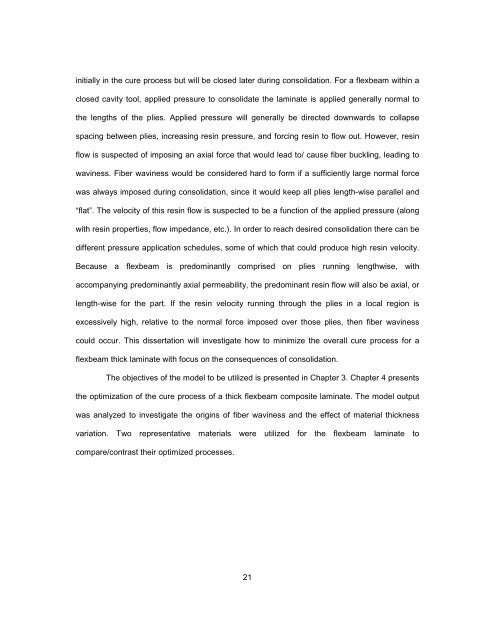TOOLED THICK COMPOSITES by ARVEN H. SAUNDERS III ...
TOOLED THICK COMPOSITES by ARVEN H. SAUNDERS III ...
TOOLED THICK COMPOSITES by ARVEN H. SAUNDERS III ...
You also want an ePaper? Increase the reach of your titles
YUMPU automatically turns print PDFs into web optimized ePapers that Google loves.
initially in the cure process but will be closed later during consolidation. For a flexbeam within a<br />
closed cavity tool, applied pressure to consolidate the laminate is applied generally normal to<br />
the lengths of the plies. Applied pressure will generally be directed downwards to collapse<br />
spacing between plies, increasing resin pressure, and forcing resin to flow out. However, resin<br />
flow is suspected of imposing an axial force that would lead to/ cause fiber buckling, leading to<br />
waviness. Fiber waviness would be considered hard to form if a sufficiently large normal force<br />
was always imposed during consolidation, since it would keep all plies length-wise parallel and<br />
“flat”. The velocity of this resin flow is suspected to be a function of the applied pressure (along<br />
with resin properties, flow impedance, etc.). In order to reach desired consolidation there can be<br />
different pressure application schedules, some of which that could produce high resin velocity.<br />
Because a flexbeam is predominantly comprised on plies running lengthwise, with<br />
accompanying predominantly axial permeability, the predominant resin flow will also be axial, or<br />
length-wise for the part. If the resin velocity running through the plies in a local region is<br />
excessively high, relative to the normal force imposed over those plies, then fiber waviness<br />
could occur. This dissertation will investigate how to minimize the overall cure process for a<br />
flexbeam thick laminate with focus on the consequences of consolidation.<br />
The objectives of the model to be utilized is presented in Chapter 3. Chapter 4 presents<br />
the optimization of the cure process of a thick flexbeam composite laminate. The model output<br />
was analyzed to investigate the origins of fiber waviness and the effect of material thickness<br />
variation. Two representative materials were utilized for the flexbeam laminate to<br />
compare/contrast their optimized processes.<br />
21
















